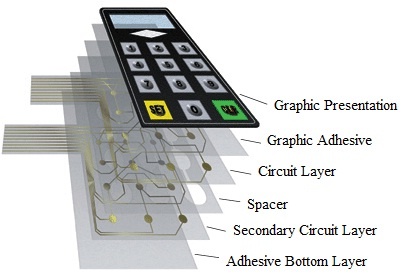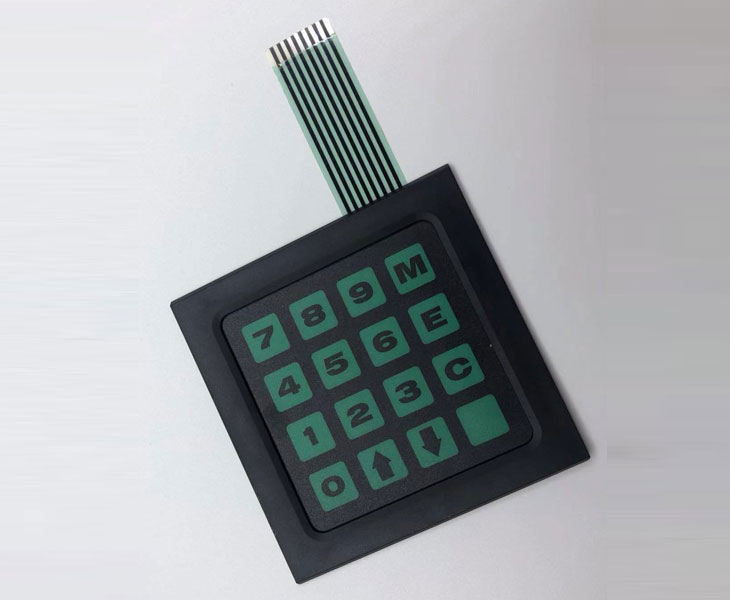The Production Process Behind Membrane Layer Change: What You Required to Know
The production process behind membrane layer switches combines careful layout, material option, and quality assurance. It begins with recognizing the ins and outs of membrane layer button style and proceeds with numerous stages, consisting of material options and printing techniques. Each phase plays a necessary role in guaranteeing capability and toughness. The complexities of layer building and the strenuous testing requirements might reveal insights that are not quickly evident. What exists beyond these foundational aspects?
Recognizing Membrane Switch Over Design
Membrane layer buttons might show up simple at initial look, their design involves intricate considerations that ensure performance and toughness. The layout process begins with a complete understanding of customer needs, consisting of the user interface's desired application and ecological factors. Ergonomics is a crucial element, as the design should help with simplicity of use while ensuring that tactile comments satisfies user expectations.Moreover, the layering of components, such as graphic overlays, glue layers, and conductive traces, have to be specifically crafted. membrane switch. This split configuration not just affects the switch's responsiveness but also influences its long life. Attention is offered to the securing strategies utilized to safeguard against dampness and dirt, which might endanger efficiency. Additionally, design considerations include aesthetics, where color pattern and aesthetic clarity improve individual experience. Inevitably, the design of membrane switches over equilibriums performance, user experience, and resilience, making sure that they fulfill the demands of numerous applications successfully
Materials Made Use Of in Membrane Switch Manufacturing
When selecting products for membrane button manufacturing, it is vital to consider both performance and toughness. The primary materials consist of polyester and polycarbonate films, which give flexibility and toughness. These films are often covered with glue to guarantee correct bonding to substrates. Conductive inks, normally composed of silver or carbon, are essential for creating electric connections within the button, permitting trustworthy operation.Additionally, a protective layer, such as a difficult layer, is frequently related to boost scratch resistance and long life. The choice of backing material, such as acrylic or foam, can substantially impact the switch's responsive feeling and overall user experience. Numerous ecological factors, including temperature and moisture, need to guide material selection to ensure peak efficiency in certain applications. Inevitably, the right combination of materials contributes to the membrane switch's performance and life-span, making educated selections essential for manufacturers.
The Printing Process: Creating Graphics and Text
The printing process in membrane switch manufacturing plays a significant function in creating premium graphics and message. Numerous visuals layout strategies are used to ensure aesthetic charm and performance, while cautious ink choice techniques are vital for toughness and efficiency. Understanding these elements is basic for attaining best cause membrane button layout.
Graphic Layout Techniques
Graphic style techniques play a necessary function in the printing process of membrane layer switches, as they specify exactly how graphics and text will eventually appear on the end product. Effective visuals design entails the calculated use fonts, shades, and designs to improve readability and aesthetic charm. Developers typically utilize vector graphics for scalability, making certain that images continue to be sharp at various dimensions. Additionally, interest to comparison and alignment is essential, as it influences customer interaction and aesthetic top quality. The incorporation of branding aspects, such as logo designs, should be handled with care to maintain brand integrity. Generally, thoughtful visuals design strategies contribute significantly to the performance and beauty of membrane layer buttons, influencing user experience and product efficiency.
Ink Option Methods
Choosing the ideal ink is vital for attaining the preferred aesthetic top quality and sturdiness in membrane layer button manufacturing. Various ink types are utilized, including solvent-based, water-based, and UV-curable inks. Each kind supplies distinctive characteristics, such as adaptability, adhesion, and resistance to ecological aspects. Solvent-based inks are usually preferred for their durability and vibrant colors, while water-based inks are more environmentally friendly but might have constraints in attachment. UV-curable inks give quick curing and durable efficiency. Furthermore, shade matching methods ensure that the selected inks align with layout requirements. Inevitably, the option of ink have to take into consideration aspects such as application technique, substrate compatibility, and end-use requirements to achieve superior lead to membrane layer button graphics and text.
Layer Construction and Assembly

Product Option Refine
A careful selection of products is essential in the manufacturing process of membrane switches, as it directly influences performance and longevity. The key products used include polyester, polycarbonate, and various conductive inks. Polyester is typically favored for its exceptional resistance to chemicals and abrasion, making it appropriate for extreme settings. Polycarbonate, on the various other hand, supplies remarkable clearness and effect resistance, which is valuable for applications calling for presence and effectiveness. Conductive inks, normally made up of silver or carbon, are crucial for producing reputable electrical additional hints pathways. Additionally, the selection of glue products affects the overall integrity of the button - membrane switch. Examining aspects such as environmental exposure, responsive comments, and aesthetic requirements overviews makers in choosing the most effective materials for their details applications
Layer Bond Strategies
Adhering layers in membrane layer switch building and construction is a crucial process that guarantees capability and durability. Numerous attachment methods are used to safeguard perfect bonding between layers, which normally include making use of adhesives, warmth, and stress. Pressure-sensitive adhesives (PSAs) are typically utilized for their simplicity of application and instant bonding abilities. Furthermore, thermal bonding techniques can be used, where heat is utilized to activate sticky homes, protecting a solid bond. The option of attachment technique mainly depends upon the materials included and the particular application requirements of the membrane button. Proper alignment and consistent application of adhesives are vital to prevent flaws, protecting the button runs effectively throughout its desired lifespan.
Quality Assurance Actions
Guaranteeing high quality control during the layer construction and assembly of membrane switches is important for preserving performance and dependability. This process generally involves several critical measures, consisting of detailed examinations at each phase of production. Producers use innovative screening approaches, such as peel examinations and adhesion analyses, to verify the stability of layer bonds. Furthermore, visual examinations are carried out to determine any kind of issues in printing or product disparities. Environmental conditions, such as temperature level and moisture, are meticulously kept an eye on to assure optimal treating and attachment. Moreover, regular calibration of equipment helps maintain precise production requirements. By carrying out these quality assurance actions, makers can greatly reduce the danger of product failure, guaranteeing that the last membrane layer switches over fulfill the called for requirements and customer expectations.
Checking and Quality Control Actions

Innovations in Membrane Layer Change Technology
As improvements in modern technology remain to develop, membrane layer buttons are gaining from cutting-edge developments that boost their functionality and customer experience. One significant development is the integration of capacitive touch modern technology, which enables even more user-friendly and responsive customer interfaces. This change not only improves aesthetics however also lowers mechanical deterioration, expanding the life expectancy of the switches.Additionally, innovations in graphic overlay products have actually brought about improved longevity and resistance to environmental variables such as moisture and UV light. These products currently provide boosted clarity and illumination, more elevating the aesthetic appeal.Furthermore, the consolidation of clever technology is transforming membrane switches over right into interactive control panels, making it possible for connectivity with IoT gadgets. This connection fosters a seamless Recommended Reading customer experience, leading the way for applications in different sectors, from healthcare to consumer electronics. Jointly, these innovations position membrane changes as critical components in contemporary tool layout.
Frequently Asked Questions
How much time Does the Membrane Layer Switch Manufacturing Process Take?
The duration of the membrane switch manufacturing process can differ significantly. Variables such as intricacy, products used, and manufacturing volume influence timelines, with typical production ranging from a few days to several weeks for completion.
What Are the Common Applications for Membrane Switches?
Membrane buttons are frequently utilized in various industries, including automotive controls, home appliances, medical devices, and customer electronic devices (membrane switch). Their convenience and durability make them perfect for applications requiring user-friendly interfaces and dependable performance in varied settings
Can Membrane Layer Changes Be Customized for Specific Needs?

What Is the Life expectancy of a Normal Membrane Layer Switch Over?
The lifespan of a common membrane layer button differs, yet generally, it ranges from 1 to 5 million cycles. Elements such as usage, atmosphere, and material check this site out high quality substantially affect durability and overall performance gradually.

Are Membrane Layer Switches Eco-friendly?
The environmental friendliness of membrane layer switches varies. Some materials made use of may not be recyclable, while others can be environment-friendly. The overall impact relies on producing materials and techniques, demanding careful factor to consider during choice and disposal. The manufacturing procedure behind membrane switches over combines mindful layout, product selection, and top quality control. It begins with understanding the ins and outs of membrane button style and advances via different stages, including material options and printing strategies. When picking products for membrane layer button production, it is necessary to ponder both efficiency and sturdiness. A cautious selection of products is important in the manufacturing procedure of membrane layer buttons, as it straight affects capability and sturdiness. The choice of adhesion method mostly depends on the products entailed and the specific application needs of the membrane layer button.